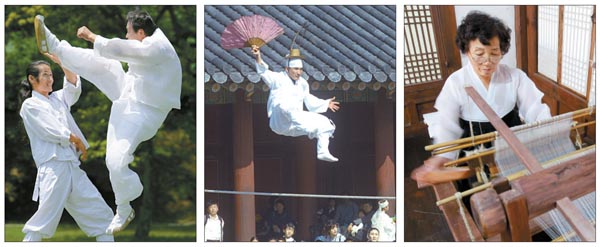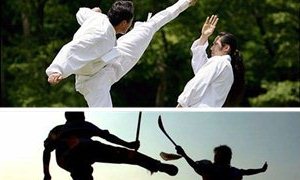Unesco honors intangible treasures

Taekkyeon practitioners / A jultagi performer / Weaving of mosi in Hansan
Three Korean cultural traditions received recognition from the United Nations Educational, Scientific and Cultural Organization (Unesco) on Monday by being given intangible heritage status.
Taekkyeon (a traditional Korean martial art), jultagi (tightrope walking) and the weaving of mosi (ramie fabric) that originated in the Hansan region in South Chungcheong were dubbed intangible cultural treasures by the Unesco Intergovernmental Committee for the Safeguarding of the Intangible Cultural Heritage in Bali, Indonesia.

Taekkyeon, the first martial art to be recognized by Unesco, involves fluid and rhythmic movements that resemble dance. The movements are also used as daily exercises, and currently there are about 50 official masters certified by the Taekkyeon Korea Association, which holds national competitions three times every year.
Before the announcement yesterday, it was expected that taekkyeon would be in competition for the recognition with China’s kung fu.
But China withdrew its bid before the committee meeting in Bali after failing to submit sufficient information, according to Unesco’s preliminary report.
While taekkyeon is a form of martial arts unique to Korean culture, tightrope walking is considered more of an entertainment, and questions have been raised over what’s unique about Korean jultagi.
While the common form of tightrope walking focuses on the acrobatic skill of maintaining balance, the traditional Korean form focuses on the interaction between the tightrope walker and an earthbound clown. The walker performs a variety of acrobatic feats on the tightrope, along with jokes, songs and dance, while the clown exchanges banter and musicians accompany the act.
The skill of weaving mosi in the Hansan region has been handed down from mothers to daughters. The region has a suitable climate for growing ramie, and its women are involved in the harvesting of the plant, bleaching, yarn spinning and the final weaving.
About 500 people in Hansan are still actively participating in mosi weaving.
Many other cultural traditions made Unesco’s list yesterday including mariachi music in Mexico.
The Royal Ancestral Rite and Ritual Music at the Jongmyo Shrine, which the kings of the Joseon Dynasty (1392-1910) used in ceremonies were added to Unesco’s list in 2001, and pansori, a traditional Korean style of narrative opera, was added in 2009.
By Lee Sun-min [summerlee@joongang.co.kr]










with the Korea JoongAng Daily
To write comments, please log in to one of the accounts.
Standards Board Policy (0/250자)